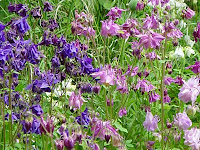Click on it if you actually want to read it!

Okay, so I "cheated" - I took all the peas and alliums out altogether. The plan is to put the garlic around the edge as part of a pest barrier, and to find somewhere at the front of the house for sugar snaps (shame about the onions). I am also going to give the bed a "jubilee year" after one full rotation, and grow comfrey on it to dig in as a fertiliser. I know that square-foot gardening is not supposed to deplete the soil, but I want to make sure... And I know it should be after seven years, but I reckon the more often I let it rest, the better the yields will be, and Year 5 seemed to be the natural place to stop, given the rotation rules.
















